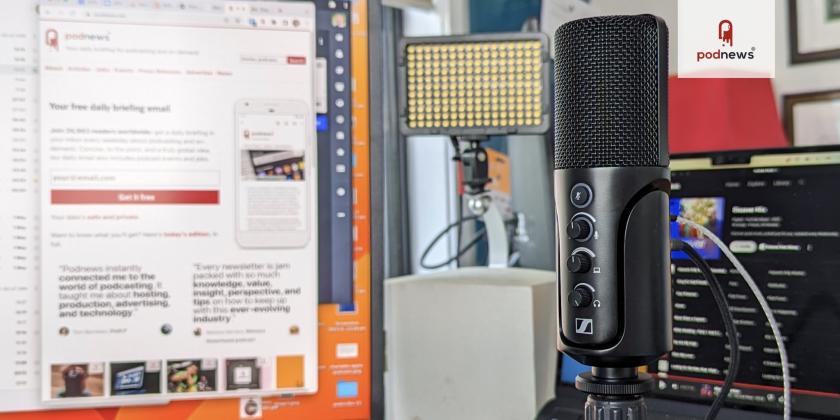
Review: the Sennheiser Profile USB microphone and streaming set

This article is at least a year old
Sennheiser is a German company which has produced a number of good pro-audio devices over the last 77 years.
(I felt I should check Wikipedia before I went any further: other venerable and decent European names, like Bush, Blaupunkt and Philips, have been bought and turned into logos to put onto cheap generic products. Sennheiser is not one of those - it remains an independent company to this day. Good.)
Launched in late March, the Profile USB Microphone Streaming Set, for US$199, contains a good-looking microphone and boom arm that seems to look good. But is it?
What you get
The microphone itself is a condenser with a cardioid pickup, so theoretically should reject echo and other sounds from the rest of the room.
The boom arm is a relatively study metal arm with a slot to route the cable to keep it tidy.
It comes in a large cardboard box, with a chunky 1.2m USB-C cable; a quick guide showing you how to use the microphone and set up the boom arm, and a very multilingual (17 languages!) set of legal compliance nonsense. The microphone itself comes protected in a cloth bag. No plastic is used in the packaging.
There’s no software to install and configure: it should just plug-and-play.
The boom arm
I’ll be honest: I unpacked the boom arm first, and put my Shure microphone on it (it fits fine). I’ve only had a desk mount so far, and wondered what difference the boom arm (US$99 when bought separately) would make. So, if you like, this is the best kind of test - I’m testing the boom arm separately from the microphone. That’s what I’m telling myself anyway.
The boom arm is a mix of matt-black metal and plastic. Unlike some other boom arms, the branding is understated. The metal support to screw onto the desk is sturdy: the three joints on the arm are quite stiff, which has a drawback (it’s a bit hard to move the microphone into a new position) and a benefit (there’s no microphone-droop here). If the boom arm is designed for the 350g Sennheiser Profile microphone, it has no difficulty dealing with the 550g Shure MV7.
You’ll know this already, but I was surprised how much of an effect the boom arm had on table noise - much less table noise is evident when the microphone is on the boom arm.
You’ll want to use the enclosed USB cable with the microphone if you can: the slot for the cable is designed to hold a particular width of cable. I’d also suggest that you might want to have the microphone’s table mount on the left, rather than on the right, otherwise you’ll be staring at the cable clips the whole time.
The microphone
The microphone itself (US$129 when bought separately) is a classy-looking, metal device - no faux-metal-but-plastic-really here. The two cable sockets are at the back - a USB-C and a headphone socket - which keeps everything neat. The front of the microphone has three level controls and a microphone mute button.
The fact that these are physical controls is a good thing. They feel of high quality, with some good damping; but the opportunity to easily control the volume, level and mix without fiddling with software control is a very good thing indeed. The headphone output can be good and loud. Having access is helpful.
The microphone is side-address rather than end-address; it has a quite effective pop-shield inside it, and when I was talking close to the microphone (off-axis) it gave a good sound: helped, I felt, by the decent volume level in my headphones.
The buttons are silent, or almost silent, when you’re using them. The microphone level adjustment turns amber when you are too loud and clipping the microphone: so it’s easy to set the correct level.
Neatly, the microphone contains a tilt mechanism, allowing you some control even if you’re using a table stand. Again, that feels good quality, with some nice damping.
The sound
After many years of radio work, I keep microphones close to my mouth: normally two inches or less. The microphone seemed to deal with everything that I gave it - louder passages gave it nothing to complain about.
I was a little nervous of a condenser, but it didn’t appear to catch any additional echo or room noise. It’s probably because that is an old wives’ tale. Like most podcasters, I’m no technical microphone expert, but I was impressed at the sound of the microphone.
You can hear what the microphone sounds like (but with some EQ to brighten the top) on this podcast episode. It has no dynamic compression anything else applied, other than the EQ to match the other audio in the middle.
In conclusion
This is a well-built microphone, and a nicely designed boom arm.
The good-quality physical controls work well. Everything about this microphone feels premium, though it isn’t priced that way.
It’s a good sounding and forgiving microphone that is built well: and a boom arm that should hold it in the right position. For the price, it seems a good buy.































































































